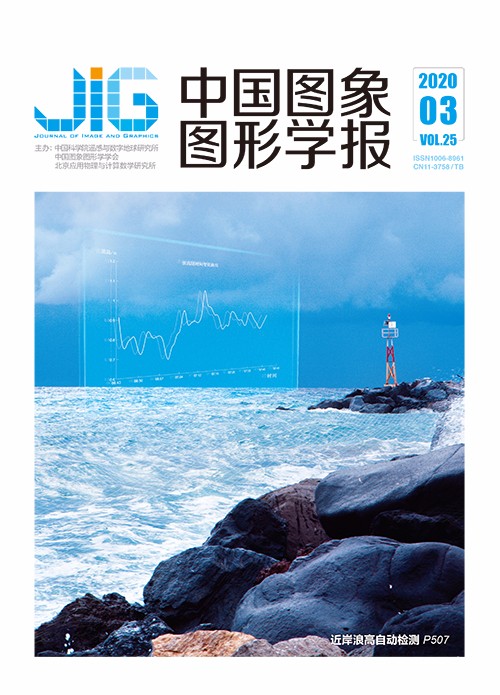
抗模糊特征提取策略下的车标识别
摘 要
目的 现有的车标识别方法尽管取得了不错的识别效果,但最终的识别率容易遇到瓶颈,很难得到提升。车标识别是智能交通系统中至关重要的一部分,识别率的微小提升也能带来巨大的社会价值。通过挖掘与分析车标识别中潜在的问题和难点,发现未能得到正确分类的图像大部分为模糊车标图像。针对车标图像中存在的成像模糊等情况,本文提出一种基于抗模糊特征提取的车标识别方法。方法 构建车标图像金字塔模型,分别提取图像的抗纹理模糊特征和抗边缘模糊特征。抗纹理模糊特征的提取使用局部量化的LPQ(local phase quantization)模式,可以增强原始特征的鲁棒性,抗边缘模糊特征的提取基于局部块弱梯度消除的HOG(histogram of oriented gradient)特征提取方法,可以在描述车标图像边缘梯度信息的同时,提升特征的抗模糊能力。最后利用CCA(canonical correlation analysis)方法进行两种抗模糊特征的融合并用于后续的降维与分类。结果 本文方法在多个数据集上均取得了很好的识别效果,在20幅训练样本下,本文方法在公开车标数据集HFUT-VL(vehicle logo dataset from Hefei University of Technology)上取得了99.04%的识别率,在本文构建的模糊车标数据集BVL(blurring vehicle logo dataset)上也取得了97.19%的识别率。而在难度较大的XMU(Xiamen University vehicle logo dataset)上,本文方法在100幅训练样本下也达到了96.87%的识别率,识别效果高于一些具有较好表现的车标识别方法,表现出很强的鲁棒性和抗模糊性。结论 本文方法提高了对成像质量欠缺的车标图像的识别能力,从而提升了整体识别效果,更符合实际应用中车标识别的需求。
关键词
Vehicle logo recognition based on anti-blur feature extraction
He Minxue1,2, Yu Ye1,2, Xu Jingtao1,2, Lu Qiang1,2(1.School of Computer Science and Information Engineering, Hefei University of Technology, Hefei 230601, China;2.Anhui Province Key Laboratory of Industry Safety and Emergency Technology, Hefei 230601, China) Abstract
Objective Vehicle logo recognition is an important part of anintelligent transportation system (ITS). The vehicle sign carries information about the vehicle, which is important for vehicle information collection, vehicle identification, and illegal vehicle tracking. The vehicle logo,which is designed in various shapes, is a distinctive feature of the vehicle with good independence and representativeness. Through the classification and identification of the vehicle logo, the range of the vehicle model can be greatly reduced, and the pre-classification of the vehicle model can be realized. In practical applications, the traditional handcrafted feature-based methods have fewer training samples, the recognition speed is fast,and the requirements on the equipment are low.Therefore, the traditional handcrafted feature-based methods appear more suitable for actual needs.Although the existing vehicle logo recognition (VLR) method has achieved good recognition results, the final recognition rate is limited and difficult to improve. VLR is a vital part of an intelligent transportation system. Even a small increase in recognition rate can bring great social value. To discover the potential problems and difficulties in VLR, we analyzed samples that have been incorrectly identified.Results show that most of the blurred vehicle logo images are not correctly classified. To extract more representative vehicle image features and effectively reduce the interference caused by blurred images, this paper proposes a vehicle identification method based on anti-blur feature extraction.Method Our method first constructed a car image pyramid based on the Gaussian pyramid, which can effectively simulate the human eye. The image anti-texture and anti-edge blur features of the image were extracted to express the information on the logo. The localized LPQ mode is used for anti-texture blurred feature extraction, which can enhance the robustness of the original features. In this process, the feature codebook is generated by clustering the sample features to quantize the feature, and the feature vector of all images is generated based on the codebook. In the process of extracting anti-edge blur features, the HOG feature extraction based on local block weak gradient elimination method is used for anti-edge blurred feature extraction, which can effectively describe the edge feature of vehicle logos and, at the same time, improve their anti-blur ability. Finally, the CCA method is used to fuse the two anti-blur features for subsequent dimensionality reduction and classification.CCA is a multivariate statistical analysis method that uses the correlation between pairs of integrated variables to reflect the overall correlation between the two sets of indicators.Result Experiments are conducted based on the blurred vehicle logo dataset (BVL) constructed in this study and two other open vehicle logo datasets. The method achieved a 99.04% recognition rate on the public vehicle dataset HFUT-VLunder 20 training samples. With the increase in the number of samples, the method has a higher upper limit of recognition rate. In addition, the method achieves a recognition rate of 97.19% on the fuzzy car logo dataset BVL constructed under 20 training samples. On the more difficult XMU, the proposed method achieves a recognition rate of 96.87% under 100 training samples. The results show that our method can achieve good recognition results and perform strong robustness and anti-fuzziness.Conclusion In this study, the scale invariance of the method is added to the construction of the car image pyramid. At the same time, the improved local quantization mode LPQ feature extraction method improves the anti-texture ability of the feature. By eliminating the local block weak gradient information of the HOG feature,we have improved the anti-edge blurring ability of the feature.Finally, the recognition ability of the vehicle logo images with insufficient imaging quality is improved through the fusion of features, thereby improving the final recognition rate, which is proven suitable for the recognition of vehicle logos in practical applications.
Keywords
|



 中国图象图形学报 │ 京ICP备05080539号-4 │ 本系统由
中国图象图形学报 │ 京ICP备05080539号-4 │ 本系统由